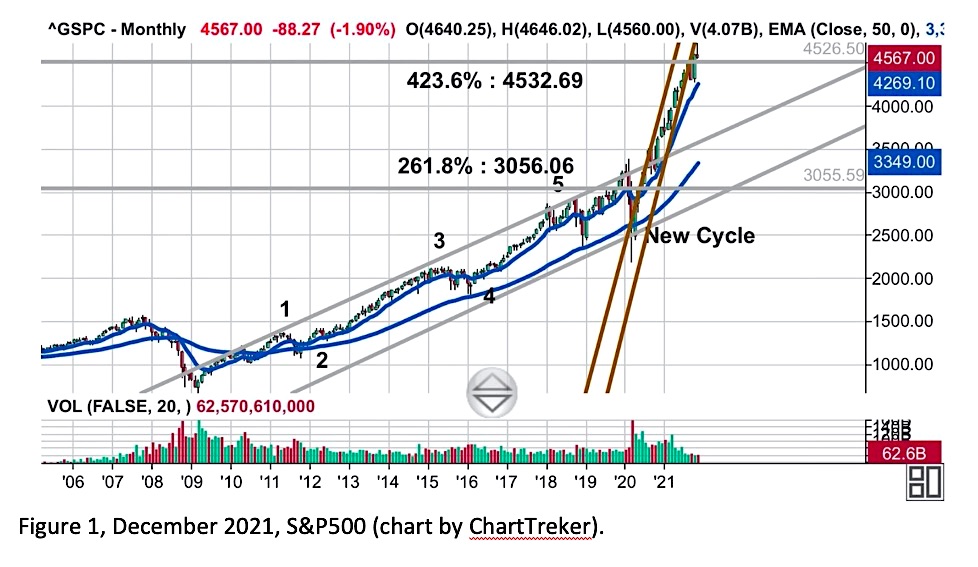In early 2021, I posed the question of where capital would flow once the flood of cheap money into US markets came to an end. Back then, the easy answer to this question was either China or the UK because both markets were near decade lows versus American markets’ all-time highs. Today, that looks less likely because there are signs that we are decoupling from China, so the hypothesis that capital will move there is called into question.
In December 2021, US markets turned bearish. Soon after oil prices peaked, Russia invaded Ukraine. Ten months later, selling continues to gain momentum. The US Dollar is now at all-times highs, and there is growing concern that we are tipping towards another global economic recession.
What can we learn from the Elliott Wave Principle and Russian economist Nikolai Kondratieff?
For those of you not familiar with the Elliott Wave Principle, the numbers 1-5 refer to periods of growth (odd) and contraction (even). The current Primary Wave (or for Kondratieff, the super-cycle) began in 1776. Kondratieff super-cycle is often associated with the technology life cycle. However, for Frost’s and Prechtor’s, The Elliott Wave Principle, it is associated more with the commodity super-cycle. The Fifth Cycle began in 1940 and hit its peak in the years from 1974 to 1982. After that, we entered a steady deflationary period that bottomed in 2016.
In my opinion, we are in the trough between the end of the Fifth Cycle of the last Primary Wave and the beginning of the First Cycle of the next.
This is dangerous territory because Kondratieff says wars occur in the troughs, but I believe the coming decoupling of the economy between the US and China may yield a cold war rather than a hot one.
Let’s start first by looking at a secondary cycle that began in 2009 that can be viewed as a microcosm of the Elliott Primary Wave. Below is the monthly price chart of the S&P500 from 2006 until December 2021. Notice that from 2009 until 2020, equities had traded neatly inside a channel. In 2020, the global economy was hit by the Covid Crisis, and most economies had gone on lockdown by March. Capital once again flooded US markets. In late 2020, equities escaped this channel to the upside, and, from a technical perspective, they entered the over-bought price area, and it was only a matter of time before prices retracted as sharply as they had risen. Today, prices have retraced back inside the channel.

The above chart represents the Elliott Wave Principle applied to a specific epoch, the 2010’s. However, where are we in terms of the Kondratieff super-cycle that began in 1776, and represents decades-long cycles of growth and decline with respect to Elliot Wave? According to the authors Frost and Prechter, the Fifth Cycle, which started at the beginning of World War II, “should collapse in the mid-1980s and be followed by three or four years of severe depression and a long period of deflation through to the trough year 2000 A.D.,” Frost & Prechter, page 187.
Did the authors get it right?
Yes and no.
In 2016, I noted the following, “In commodities, the trend has been more volatile, beginning with the Oil Crisis of 1973. However, it is notable that commodities saw lower highs from the early 1980’s until 2000’s.” (https://www.seeitmarket.com/low-commodity-and-wage-costs-will-drive-new-growth-cycle-15268/). Frost and Prechter accurately identified when the long period of deflation (in terms of the commodity super-cycle) would begin. However, rather than a “collapse,” the deflationary cycle began a steady decline, which lasted throughout the first two decades of the 21st century. It was so steady that Ben Bernanke called the period from 1982 to 2006 “the Great Moderation,” crediting US monetary policy with keeping inflation down. In reality, we did not see a bottom in commodities until 2016 and again in 2020.
Where do we go from here?
“Kondratieff noted that ‘trough’ wars, i.e., wars near the bottom of the cycle, usually occur at a time when the economy stands to benefit from the price stimulation generated by a war economy, resulting in economic recovery and an advance in prices,” Frost & Prechter, page 187.
Is the Russian invasion of Ukraine the “trough” war? I do not think so. The Ukraine War, along with the pandemic, has simply shined a light on the vulnerability of our overreliance on other nations to produce everything from semiconductors to band aids, i.e., China. While the prospect of armed conflict with China dominates the news, the ongoing signs that the US and China are moving towards a permanent economic decoupling has yet to reach public consciousness.
However, war does not oblige the raising of arms and nobody knows how this conflict will play out. If we begin to see physical signs that industry is moving out of China and over to the US side of the economy, resulting in expectations of more jobs and higher prices that are driven by demand instead of supply – creating the “price stimulation” that Frost & Prechter talk about – that would be a sign that our conflict with China has entered a new phase, that our “trough” war will be fought, like the Cold War, economically and ideologically, with (hopefully) only sporadic military excursions, and that we’ve finally entered a new cycle. This should, also, coincide with the final test of the bottoming of commodities, just as it first tested a bottom in 2016, and again in 2020.
In summary, the current intermediary cycle that began in 2009 will end when we enter the First Cycle of the next commodity super-cycle wave.
Reference: Frost and Prechter (1978-2005). Elliott Wave Principle. New Classics Library.
Twitter: @rinehartmaria
The author may have positions in mentioned securities at the time of publication. Any opinions expressed herein are solely those of the author, and do not in any way represent the views or opinions of any other person or entity.








